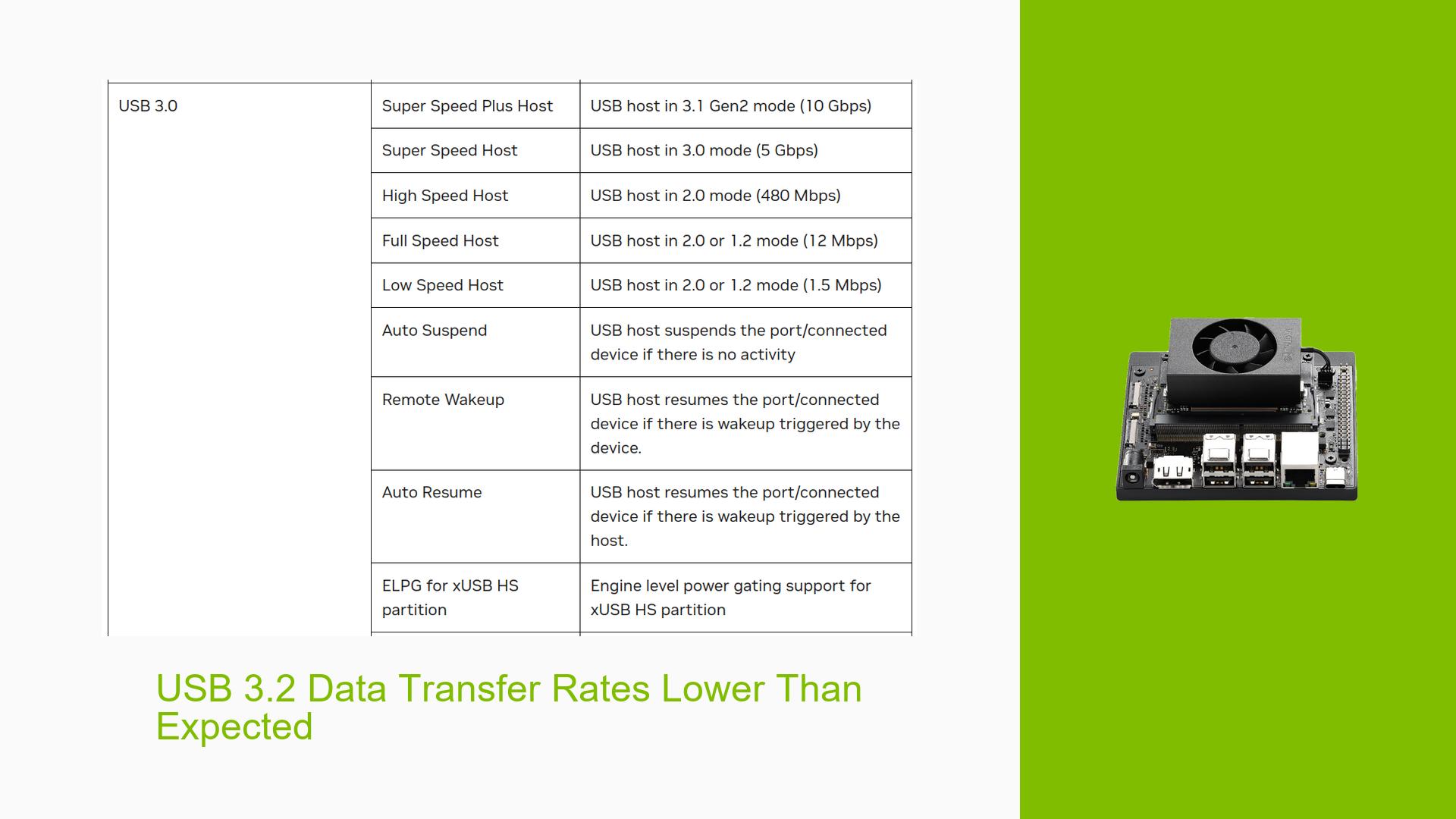USB 3.2 Data Transfer Rates Lower Than Expected
Issue Overview
Users have reported significantly lower-than-expected USB 3.2 data transfer rates on the Nvidia Jetson Orin Nano Dev board, specifically on custom carrier boards. The symptoms include:
- A recorded data transfer rate of only 38 MB/s when transferring a 2.0 GB file.
- The issue occurs while executing data transfer commands, such as
pv, in a Linux environment running L4T version R35.5.
The problem seems to be consistent across multiple attempts, indicating that it is not an isolated incident. Users have noted that the performance on the Nvidia development kit is normal, suggesting that the issue may be specific to custom configurations or setups.
The low performance impacts user experience by hindering the expected speed of data transfers, which can affect application performance and overall system functionality.
Possible Causes
Several potential causes for the low USB 3.2 performance have been identified:
-
Hardware Incompatibilities or Defects: Custom carrier boards may have different hardware configurations that could affect USB performance.
-
Software Bugs or Conflicts: Issues with the L4T version or specific drivers could lead to suboptimal performance.
-
Configuration Errors: Incorrect settings in the device tree or USB mode configurations may lead to reduced transfer speeds.
-
Driver Issues: Outdated or incompatible USB drivers could cause performance bottlenecks.
-
Environmental Factors: Power supply issues or thermal conditions could affect USB performance.
-
User Errors or Misconfigurations: Improper setup by users could result in incorrect operation of USB ports.
Each of these causes can contribute to the observed problem, particularly configuration errors related to device tree settings.
Troubleshooting Steps, Solutions & Fixes
To address the low USB 3.2 data transfer rates, users can follow these troubleshooting steps:
-
Check Current USB Configuration:
- Use the
lsusbcommand to check the current USB configuration and identify which modes are active. - Command:
lsusb
- Use the
-
Compare with Development Kit:
- If possible, test the same SSD on an Nvidia development kit to compare performance metrics.
-
Inspect Device Tree Settings:
- Verify the device tree settings for any incorrect mappings, particularly for USB ports.
- Look for the property
nvidia,usb2-companionrelated to USB3 and ensure it is correctly configured.
-
Correct Device Tree Issues:
- If misconfigurations are found in the device tree settings, update them accordingly.
- After making changes, reboot the system and retest the data transfer rates.
-
Update Drivers and Firmware:
- Ensure that all drivers and firmware are up-to-date. Check Nvidia’s official documentation for any updates related to L4T R35.5.
-
Test with Different Hardware Configurations:
- If issues persist, try using different SSDs or USB devices to rule out hardware-specific problems.
-
Monitor System Performance:
- Use tools like
dmesgto check for any error messages or warnings that may indicate underlying issues. - Command:
dmesg | grep usb
- Use tools like
-
Consult Documentation:
- Refer to Nvidia’s developer guide for additional insights on USB configurations and troubleshooting steps:
Nvidia Developer Guide
- Refer to Nvidia’s developer guide for additional insights on USB configurations and troubleshooting steps:
-
Best Practices for Future Prevention:
- Regularly update software and firmware.
- Maintain proper documentation of configuration changes made to hardware setups.
By following these steps, users can diagnose and potentially resolve issues related to low USB 3.2 data transfer rates on their Nvidia Jetson Orin Nano Dev boards. Notably, correcting device tree settings has been highlighted as a successful solution by multiple users in the forum discussion.
